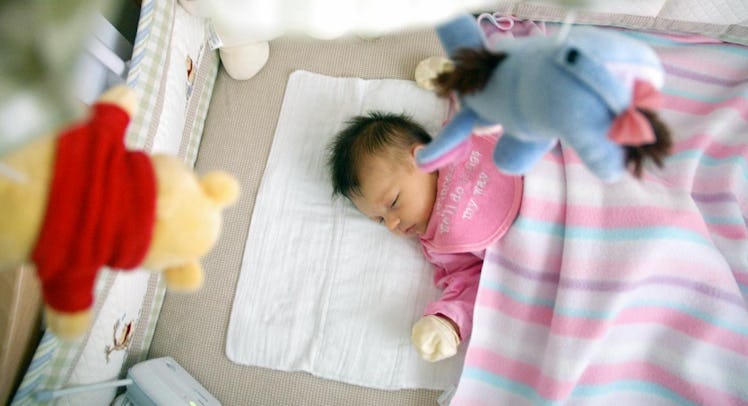Everything You Need To Know About Reducing The SIDS Risk
7 ways everyone can sleep tighter.

The first year of your kid’s life is obviously going to freak you out. A lot. That creepy soft spot will definitely freak you out. As will the unnatural color of their poop. Also, you’ll be freaked out that when they look into your eyes they can see into depths of your very soul. And, oh, those eyes judge! They burn with judgement!
READ MORE: The Fatherly Guide to SIDS
But look, if you’re not struggling with that last freak out, be grateful your biggest freaky situation for a couple of months will be combating Sudden Infant Death Syndrome (SIDS). Because unlike your spawn’s unnaturally terrifying probing gaze, SIDS is an issue that very smart people are working to combat. And there are very many guidelines for you to keep your baby safe.
What Is SIDS
The definition of SIDS is pretty simple. It is any death that occurs due to an unknown cause, without warning, in an otherwise healthy baby under 1-year-old. These deaths commonly occur in cribs, which is why SIDS was once known as “crib death.”
You may also hear the term Sudden Unknown Infant Death Syndrome (SUIDS) used to describe these deaths. SUIDS is the preferred CDC term. It includes an expanded definition that includes accidental strangulation and suffocation, as well as death due to causes that remain unknown due to inadequate investigation. SUIDS incorporates SIDS, but the numbers on SIDS are collected independently.
Those numbers show that 1,500 infants died of SIDS in 2014. Luckily that number has seen a steady decline over recent decades.
What Causes SIDS
As the definition would suggest, no one really knows what causes SIDS. Which sounds like your kid came into the world with an invisible psychopathic monster in tow. Instead of entertaining the possibility it might be something from a parallel dimension, here are the facts science does know. Which is good. But, it includes a mix of things you can and cannot control. Which is bad.
You Can’t Control
Birth Weight: If your baby is born underweight or prematurely they may be at higher risk of SIDS
Respiratory Infection: A baby that has recently suffered a cold have breathing problems that lead to SIDS
Brain Issues: Abnormalities in the portion of the brain that controls breathing could contribute to SIDS
Things You Can Control
Stomach Sleeping: Snoozing front-side is considered dangerous because it could lead to trouble breathing
Cozy Sleeping: Soft blankets and pillows in your kids sleeping area could lead to suffocation
Sleeping In A Parent’s Bed: Sharing a bed with your baby could be very dangerous, particularly if you toss and turn, or sleep with lots of blankets, comforters, and industrial-sized body pillows.
How To Fight SIDS
The most recent recommendations from the American Academy Of Pediatrics (AAP) are very clear: babies should share a room (not a bed) with parents until they are at least 1-year-old. The AAP says that this practice can decrease the risk of SIDS by 50 percent. It should be noted, though that the room sharing is just that. The AAP is still very clear that parents should not share a bed with their kid. Getting it on again was going to be extremely unlikely either way.
Even if you are sharing a room with your kid there are additional suggestions:
Back To Sleep: Baby’s should sleep on their backs, not their fronts. Your fears of them getting a flat head, or not being able to learn to roll over, can be mitigated by shifting them as they sleep and allowing extra tummy time.
Breastfeed: Just one more thing to add to the list of amazing things boobs can do. Breastfeeding is known to decrease the risk of SIDS.
Laid Bare: Your baby’s crib should not look particularly cozy. Things like blankets and stuffed animals and pillows can be huge suffocation risks. Go with a mattress and a tight sheet. A sleep sack or swaddle is acceptable, but you don’t want your kid to overheat. If you absolutely have to give your kid a blanket, tuck it tightly into the bottom of the mattress and make sure it only covers your kid up to their shoulders.
Offer A Pacifier: Establish breastfeeding first (if you’re going that way) before offering a pacifier which might help reduce the risk of SIDS.
About Baby Health Monitoring Devices
There’s a whole new set of connected health monitors for babies out on the world. The AAP warns, however, that they are not effective in reducing the risk of SIDS. In fact they might even be dangerous if parents get a false sense of peace of mind.
In the end, taking these precautions can make sure SIDS is one freak out that you weather fairly easily. After that you can obsess on your kids unnerving ancient stare. It burns!
This article was originally published on